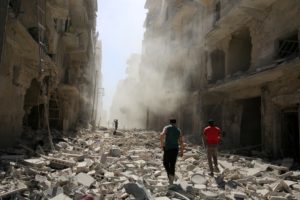Special to WorldTribune.com
UNITED NATIONS — The tumultuous events which have swept the Mideast like a malevolent sandstorm have hardly abated; crises and conflict are now nearly entrenched. Thus looking back at the results of President Barack Obama’s two-term legacy, its clear we are facing a Mideast meltdown with dangerous and far reaching consequences for the region and the world at large.
In June 2009, speaking at Egypt’s Cairo University, Barack Obama made a far reaching and ambitions address to the Muslim world.
In a carefully crafted outreach, Obama began by offering his hope for a “new beginning between United States and Muslims around the world.”

The geopolitical Mideast map which the Obama Administration inherited was overshadowed by the ongoing conflicts in Iraq and Afghanistan. But even Obama admitted Afghanistan was “not a conflict of choice, but of necessity.” Iraq however presented the gordian knot for the new Administration to untie. In doing so he, and his former Secretary of State Hillary Clinton, unraveled the Middle East.
The Iraq Obama inherited was seemingly stable but with 144,000 American troops in country.
Saddam’s dictatorship was deposed. The 2007 Bush military surge had succeeded and Iraq was beginning to show long awaited signs of stability. But by a precipitous politically-motivated withdrawal of U.S. forces, Obama’s policy mortgaged the hard-won gains made through spilled blood and treasure and moreover allowed Iraq’s venal sectarian divide to dominate the Baghdad government.
While U.S. military brass and even many in the Administration believed in keeping a residual military force in country as a commitment to continued stability, the Baghdad rulers pressed for a complete withdrawal. Obama gladly obliged.
Thus the outcome, which witnessed the rise of ISIL, reflected a quick political fix rather than a commitment to long-term stability. Key Iraqi cities fell to the Islamic militant insurgents. Fast forward. Now thousands of American special forces are back in Iraq trying to help the Iraqi military retake lost territory. We are still paying the price for Obama’s hasty withdrawal.
Iran in a sense represented a far more dangerous geopolitical challenge. The Islamic Republic’s nuclear weapons program as well as the regime’s state support of terrorism presented a long standing challenge to American policy.
Obama’s multinational diplomatic “deal” reached with Tehran to presumably defuse the nuclear threat (primarily to Israel), remains just that — a “deal” with a theocratic dictatorship who remains a clear and present danger to American, Israeli not to mention Arab Gulf interests.
Following the Iran “deal” the Obama Administration has dramatically loosened most economic sanctions and has literally sent planeloads of cash ($400 million) to the Islamic Republic to cover former frozen assets from the 1979 Islamic Revolution. Not surprisingly, Boeing is selling Iran Air scores of modern civil aircraft. You can’t make this up!
Egypt While much of the Mideast appeared strangely static, the Arab Spring exploded in Cairo in 2011. Pro-democracy demonstrations toppled the authoritarian but pro-American rule of President Hosni Mubarak ushering in a swirl of events which resulted in an elected but thuggish Muslim Brotherhood regime. Soon rising frustrations the following year led to a new military government in Cairo. Once close political ties between Cairo and Washington are destabilized.
Syria exploded in 2011 as demonstrations tried to topple the entrenched Assad Family regime, a secular but longtime Russian client. Syria’s original uprisings were probably democratic but soon were hijacked by hardline Islamic Al Qaida forces. While Obama fiddled rhetorically while supporting the Syrian uprising, his administration led from behind regarding decisive action. Before long Russia decided to support their longtime client. Over 500,000 people have been killed; Aleppo is a humanitarian hell. Millions of Syrians have become refugees, fleeing into neighboring Lebanon, Jordan and Turkey and flooding into Europe. There’s no end in sight.
Libya saw its longtime dictator Col. Gadhafi toppled by a series of tribal uprisings. Later the USA and France sent massive air support to help break in the impasse in the civil war. But what then? Radical jihadi militias burnt down the American consulate in Banghazi and killed four Americans including Ambassador Chris Stevens. Libya remains in chaos and serves as a conduit for refugee flows into Italy. While we are well rid of Gadhafi, what were Hillary Clinton’s State Department plans following the overthrow?
Yemen Once touted as an Obama Administration’s socio-political success story, Yemen has descended into a dangerous spiral of conflict amid sectarian divides. Saudi led coalition forces battle Iranian backed rebels. A UN official warned, “The state of Yemen is broken,” and there are 20 million people in need of humanitarian assistance.
Turkey The once rock solid and reliable relationship between the USA and Turkey is threatened. Tragically Turkey’s once staunchly secular Republic is increasingly Islamic-lite under the authoritarian rule of President Erdogan. Ties with Washington are deeply frayed.
The Mideast suffers the aftershocks of Obama’s fundamentally failed foreign policy.
America’s new president inherits this geopolitical map.
John J. Metzler is a United Nations correspondent covering diplomatic and defense issues. He is the author of Divided Dynamism the Diplomacy of Separated Nations: Germany, Korea, China (2014). [See pre-2011 Archives]

